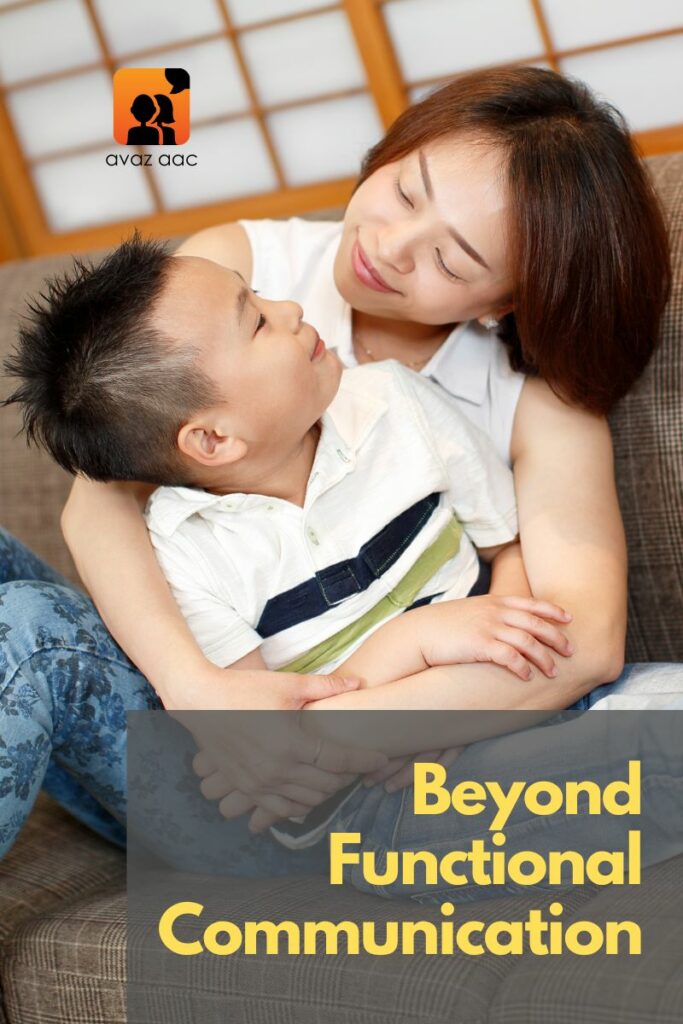Communication is a complex phenomenon. It serves certain functions in our everyday life. That said, we also communicate to share our feelings and emotions – the byproducts of our everyday activities. Through this blog let us see how communication goes beyond just functional communication.


What is Functional Communication?
Functional communication refers to one’s ability to independently communicate their basic needs and feelings to others. Functional communication usually refers to language skills required to communicate in various day-to-day situations.
Even though functional communication skills are necessary to perform everyday activities independently, expressive communication skills are equally important to build language and form social relationships.
Communication Functions
What are the functions of communication? The answers and perspectives to this is ever evolving. Initially, functions like requesting, greeting, and rejecting were considered the only functions. Today, functions like commenting, protesting, asking a question, sharing information etc are also being acknowledged.
Specific kinds of learners begin learning functional communications skills first. Children with complex communication needs and children who are gestalt language processors are typically the ones who go through this training. Since they develop language in a different way, they may take longer to acquire these skills.
Sadly, owing to this delay, conventional systems presume such learners to be incompetent. It presumes that they are incapable of thinking independently or even having their own ideas to communicate!
Learners with CCN – Are We Letting Them Down?
Here is what currently happens with children who have complex communication needs:
We may ignore communication attempts of children who are echolalic (repeating words or chunks of words) as meaningless gibberish. We need to understand that Echolalia is communication. It serves communicative functions for children who are Gestalt Language Processors.
Movie scripts or songs may sound irrelevant to us – but these are the communicative attempts of Gestalt Language Processors. All of this counts as spontaneous communication. Encouraging it has shown tremendous improvement in language acquisition. Unfortunately, we may knowingly or unknowingly, mitigate these echo scripts by providing them with functional communication scripts.
For example, a child who is acquiring language as gestalts might be using a phrase, “Time out”, which they picked up from a game, to say no, to ‘refuse’. Their echolalia serves a function. Or alternatively, a child may sing a song when they feel bored, because the song may give their mind a scenario that is interesting.
There are also children who are non-verbal and they may stim, they may use other modes of communication to tell us something. All these modes of communication are legitimate attempts, and all of them have purpose.
Communication – A Really Complex Function Indeed!
Mitigating echolalia demotivates the inherent curiosity of the child. This could involve replacing it with a phrase having a communicative function, like “Please give me water”. Or substituting or suppressing other modes of communication.
Another issue arises while assessing the communicative competence of a child. Most often than not, we end up treating communication as an independent or stand-alone entity. We are not taking into account the fact that communication is a joint activity.
Imagine yourself in a restaurant trying to order something. The waiter at the restaurant may show you a menu, might prompt you to a particular section of the menu or a dish. You may choose to ask them about what’s being served at the next table. Or you may simply point at an item on the menu to indicate what you want to order. You may end the order with a ‘Thank you’ or you may just choose to smile. So what does this tell us?
Communication is always between two or more people. A conversation you make depends on the setting and the other person’s response. It is also never entirely made up of ‘spoken’ words. Communication is more complex than we can imagine. Then why assess the communication skills of those who acquire language differently without considering these factors?
Linguistic Potential and Curiosity
Forcing only communicative functions on children who are developing language differently may suppress their linguistic potential and curiosity. Expressive language is equally important for facilitating spontaneous communication. SO what are some of the things we can do differently?
- Do not mitigate echolalias by replacing them with functional phrases, instead work towards natural language acquisition stages.
- Do not ignore stimming and impose behavior control, instead observe the pattern and environment where it happens.
- Let us presume competence, always.
- Let us acknowledge and respect all modes of communication!
Avaz is an Augmentative and Alternative Communication app. To know more about Avaz AAC, click here.
If you are a speech professional interested in taking a product demo, click here.
Reference
- Marge Blanc – Natural Language Acquisition on the Autism Spectrum: The Journey from Echolalia to Self-Generated Language, 2012




That was a brilliant article. So what are a few startegies to help a child (who uses certain words repeatedly), to acquire better language skills without lowering his confidence? Because although the same words are repeated, the attempt is spontaneous and we have to keep encouraging that. At the same time we also would like to add on to his expressive language. So what are a few practical tips? Thank You